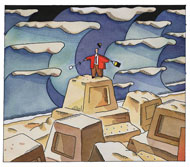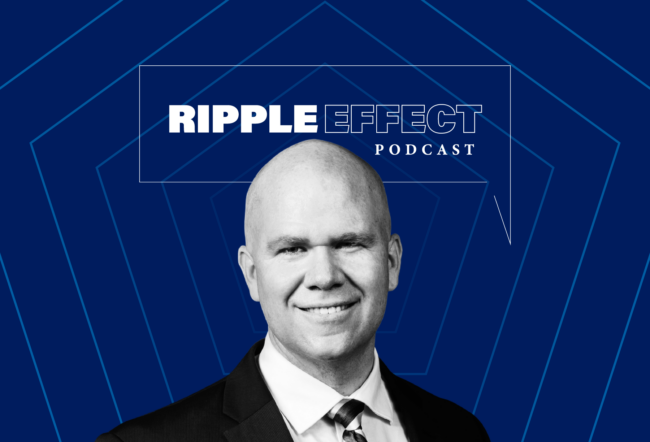Whether or not Congress approves the Bush Administration’s $700 billion Wall Street rescue plan, a question hangs in the air: Will it work? Economists and financial experts don’t all agree that a taxpayer-funded purchase of troubled mortgage securities is the best way to attack the credit crunch. Some support it, while others prefer alternatives like a loan program for hard-hit financial institutions or a government-backed mortgage refinancing program — strategies that could supplement the administration’s plan or replace it if it fails.
Regardless of their take on the rescue, most experts agree there is a key unanswered question at its core: How would the government know if it is paying the right price for the exotic securities it would buy from troubled firms? Pay too much and the taxpayer could lose hundreds of billions of dollars. Pay too little and the bailout would fail.
“The big question is, at what prices will the Treasury buy the debt?” says Wharton finance professor Richard Marston. “The problem with this crisis is that it’s not just about confidence [in the markets]. It’s also about the huge losses that banks, investment banks, insurance companies, hedge funds, etc. have suffered. The Feds are betting that restoring liquidity will be enough. Maybe not.”
Marston and other experts were interviewed in the days before the final touches were put on the rescue plan, but after it was clear that it would entail a government purchase of troubled securities. Issues debated in the final days — caps on executive pay, the makeup of an oversight board, a public equity stake in firms that are helped, and the pace at which funds will be provided to the program — have little bearing on whether the asset-purchase plan could succeed, most agreed. All described the financial situation as perilous and said some sort of government response is needed.
Wharton finance professor Jeremy Siegel believes the plan could channel enough money to enough banks to get them to resume lending. “I think this is the best way to go,” he says. Mark Zandi, chief economist and cofounder of Moody’s Economy.com, concurs, describing the plan as “a very elegant idea. The principal benefit is that it establishes a market price for these assets that have no price. This will allow banks to write down [losses] appropriately, which is absolutely necessary to get capital flowing back into the banking system.”
But Olivia S. Mitchell, professor of insurance and risk management at Wharton, is not as convinced. “The plan is not doing anything to remedy fundamental problems with the mortgage market.” To work, a remedy must help homeowners renegotiate mortgages on properties now worth less than the owners owe, she says. “That fundamental problem is not being dealt with in this bailout.”
A Profitable Plan?
The plan was proposed September 20 by Treasury Secretary Henry Paulson, with support from Federal Reserve chairman Ben Bernanke. Despite changes negotiated with Congress, the heart of the plan has survived for now, providing for the government to purchase assets like mortgage-backed securities from financial firms. Many of these have become impossible to sell because rising homeowner defaults on mortgage payments make the securities’ values uncertain.
Banks and other financial firms have suffered enormous losses on these securities and may well lose more. That has left lenders wondering whether potential borrowers will be unable to pay loans back, causing a pullback in lending of many types.
By purchasing the risky assets, the government could reduce worries about hidden liabilities and furnish cash that firms could use for operations and loans, according to Paulson and other supporters of his plan. In theory, this will get the credit markets working again. The plan’s proponents also argue that doing nothing would have even greater consequences, as businesses fail to get money they need and ordinary people who cannot get mortgages, credit cards and auto loans cut back on spending, undermining the economy.
While much of the debate has focused on the potential $700 billion “cost” to taxpayers, backers of the Paulson plan prefer to describe this outlay as an investment — buying assets at depressed prices and hoping the markets will turn around. Eventually, the government would hope to sell those securities, recouping some or all of what it had paid, and turning a profit if prices rise enough. “I’d be shocked if we spent anywhere close to $700 billion,” Zandi says. “I think the net cost to the taxpayer when all is said and done will be pretty modest.”
Author and former hedge fund manager Andy Kessler argued in a September 25 opinion piece in The Wall Street Journal that the government could earn between $1 trillion and $2.2 trillion through the Paulson plan. It would buy distressed assets at discounts of 75% to 80% from their original prices, then push their values up by using the government’s unlimited borrowing power to pump money into the economy to boost growth, he said, adding that unlike hedge funds and other investors, the federal government has endless staying power and can outwait any downturn.
Siegel, too, believes the plan could turn a profit. Government purchases will help establish asset prices, encouraging other investors to look for bargains, and possibly leaving the government spending far below the $700 billion called for in the plan, he says. Because there is little trading and a great deal of panic, there may be securities trading at 30 cents on the dollar when they’re really worth 50 cents, he notes. “If this does facilitate price discovery and liquidity, then there will be less need for the government to come in.”
“One of the things that the government has not conveyed very effectively is the intellectual foundation of what they are doing,” says Wharton finance professor Franklin Allen. “They believe the securities are mispriced … [that] values have broken away from fundamentals. I would agree with their view.”
The underlying problem of mortgage delinquencies and foreclosures has not grown as bad as the tumbling prices of mortgage-backed securities suggests, Allen notes. He cites a Bank of England study which found that prices on AAA-rated subprime mortgage-backed securities reflect a 76% default rate on the underlying mortgages, far above actual default rates. “This would require something worse than the Great Depression. Most other indicators suggest this is not the outlook.”
When an asset bubble bursts, prices typically fall to excessive lows and then rise to a more rational level, Allen adds. “If you believe the government’s view, the risk to the taxpayer is small. It is quite likely they will get most of the taxpayers’ money back. This has been the case in many crises before.” Indeed, the government may even make a profit if it implements a plan to acquire stock warrants in firms it helps, he says.
Buying Waste
Others, however, note that it’s very hard to know which securities are underpriced and which are not. Financial firms are unlikely to sell securities to the government that they think will rebound. Instead, critics say, they will dump the toxic waste, leaving the taxpayer to bear the loss.
The government is considering a reverse auction system — “reverse” because there would be one buyer and many sellers instead of one seller and many buyers, as in a standard auction. The government would describe a category of securities it wanted to buy, purchasing them from bidders willing to take the lowest prices.
But these are not standardized securities like futures contracts for corn or wheat. Each is highly customized and unique. Given the government’s need to buy them in huge blocks, it may have to use bidding criteria too broad to filter out the toxic waste, says William Frey, president of Greenwich Financial Services, a Connecticut firm that specializes in mortgage securities.
Firms that create these securities typically start with bundles of up to 10,000 mortgages, he says. Then they produce a series of securities of various qualities to pass homeowners’ monthly mortgage payments on to the securities’ owners. The lowest quality, a non-rated level, offers the highest yields but is the first to stop receiving payments if some homeowners fall behind. The top-rated, or AAA securities, pay the lowest yield but are the last to suffer from homeowner defaults. Three or four other qualities fall in between.
One problem is that the ratings turned out to be based on overly optimistic views of the health of the underlying mortgages, and default rates have been far higher than expected. Ratings labels now have little meaning.
Moreover, even securities carrying the same rating might be very different from one another. Often the AAA slice, or tranche, was itself divided in two, Frey says. The higher-quality half would suffer no losses until the other half was wiped out. Hence, the high-quality portion might be worth 96 cents on the dollar today with the other half worth only 25 cents, despite carrying the same AAA rating and coming from the same bundle of mortgages.
To put a value on these securities, one needs not only to predict the rate of homeowner defaults, but the timing of the defaults, Frey notes. Defaults further in the future do less damage because investors receive payments in the meantime. In addition, two securities that appear nearly identical can be very different depending on the location of the underlying mortgages. Mortgages in hard-hit California are much riskier than ones in stable Idaho.
“You have to get down to zip code-specific areas that are the collateral in the pool and project how severe the losses are and when they are going to occur in the pool,” he says, adding: “You need someone who knows what they are doing, and there’s not too many of those around.”
Government Loans
Because of these and other uncertainties, some experts prefer alternate approaches to the problem.
Jack M. Guttentag, an emeritus finance professor at Wharton who runs The Mortgage Professor website, says the government should loan money to troubled institutions, allowing them to use mortgage securities as collateral. This would pump needed cash into the financial system without having the taxpayer shoulder the cost.
Because the securities are so varied, the government would have “no way whatsoever” to know if it is paying a reasonable purchase price in the Paulson plan, he says. “I think the whole thing is inferior to a loan program.” A loan program could rely on value estimates from agencies like the Federal Home Loan Bank, which already has experience with this, he adds. Because of the uncertainties today, the government would build in a safety margin by limiting loans to sums substantially below its estimate of the collateral’s value. In addition, it would charge a high “penalty rate” of perhaps 10% to discourage unnecessary borrowing. Taxpayers would profit from the interest earnings.
Because of the collateral requirement, there would be no need to put a cap on the amount that could be loaned. In addition to pumping money into the system, a loan program would help restore private lending because lenders would know that borrowers could get government loans in a pinch, Guttentag says.
Other experts propose attacking the root of the problem by helping homeowners avoid the defaults and foreclosures that are undermining the values of mortgage-backed securities. Democrats wanted the Paulson plan to give bankruptcy judges the authority to reduce homeowners’ mortgage debt and interest rates. They failed. But even if they had succeeded, this case-by-case approach could not help enough homeowners fast enough to buoy the financial markets, Mitchell says. “It is very cumbersome and slow.”
Others have proposed a government-run process that would allow homeowners to replace current mortgages, many with adjustable rates carrying high interest rates, with 30-year, fixed-rate mortgages charging less. A new mortgage would be based on a property’s current value, and the original lender would take a loss if the original mortgage was for more. If a participating homeowner sold a property for more than was lent, gains would be shared with the government.
This idea is modeled on the HOPE for Homeowner’s Act of 2008, passed in March. While that program made lender participation voluntary, some experts, especially consumer advocates, want a more forceful program to compel lender participation.
The difficulty with this approach, Mitchell says, is that once mortgages are converted into securities and sold to investors, there are many parties with a stake in the process, and not all would want to change the loan terms. It is far different from the days when a local bank kept mortgages it issued on its own books and could deal directly with a homeowner in trouble. “The problem is that nobody in the chain of securitization has an incentive to renegotiate the initial price of the mortgage,” she says.



